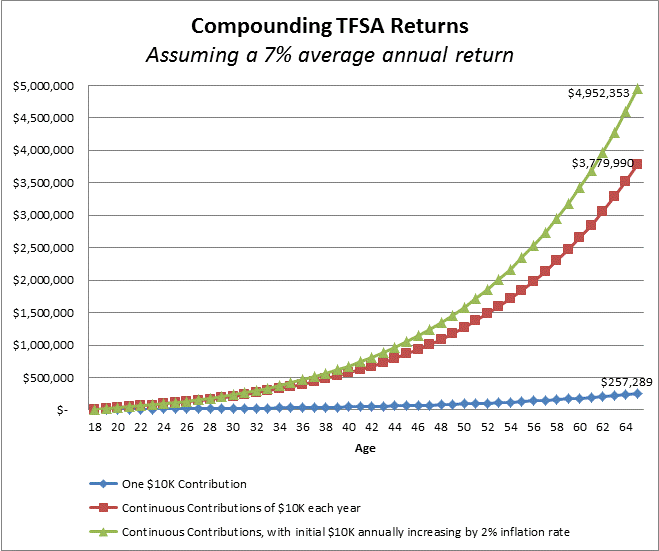David Baskin
April 29, 2015
When TFSAs first came on the scene six years ago, I confess that we were under-impressed. At $5,000 it would take a long time for our clients to accumulate a meaningful amount inside a plan, and an even longer time to save any serious taxes. This month, things changed. By almost doubling the annual contribution limit to $10,000 per year, the Federal Government has elevated TFSAs into the big leagues.
Consider the following:
•Assuming a 7% return per year after fees (a very achievable return for a high equity allocation account) a couple, each 60 years old today, making the maximum contribution could accumulate over $1,000,000 by the time they reach 80, and save about $200,000 of taxes.
•A 25 year old who makes the maximum contribution every year and gets the same 7% return would have an account of almost $2,000,000 at age 65 and would save about $400,000 in taxes.
•A single gift of $10,000 given to an 18 year old would be worth over $250,000 at age 65.
These numbers, aided by the most powerful force in finance, the magic of compounding over a long period, are simply too big to ignore. From now on, a TFSA will be an essential part of our tool kit.
What about the interaction of RRSPs and TFSAs? Which should get the money if there is not enough available to top off both? The permutations and combinations of TFSAs and RRSPs are endless, and as various as the individual circumstances of every family. However, there are some general guidelines. Money from whatever source (earned, gifted, inherited) once put into a TFSA will never pay a penny of tax on interest, dividends or capital gains. It is a true (fully legal!) tax avoidance vehicle. RRSPs, on the other hand, only defer taxes on earned income. The money inside an RRSP can compound unhindered by tax, but will pay tax when it is later taken out, usually in retirement.
Those in low tax brackets who are unable to top up both a TFSA and an RRSP will almost always be better off contributing to the TFSA first. Age comes in to the equation as well. TFSAs are most powerful when there are many potential years of compounding. An 18 year old might get 60 or more years to grow a TFSA, while for a 70 year old the arithmetic is less compelling. Finally, the fact that the maximum contribution to an RRSP is more than twice as large as the highest allowable TFSA contribution (the RRSP limit in 2016 will be over $25,000 for an individual) can allow an individual to build an RSP into a very large tax deferred source of income in retirement.
In Ontario the top income tax bracket is over 50%. Your savings come from income that has already been heavily taxed. If a part of those savings, even a small part, can grow tax free, it would be foolish not to take what has been offered. Your account manager would be happy to discuss this with you.


